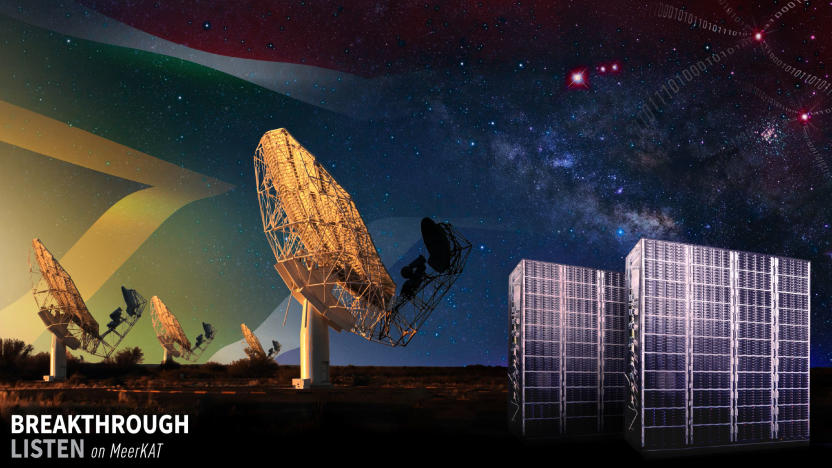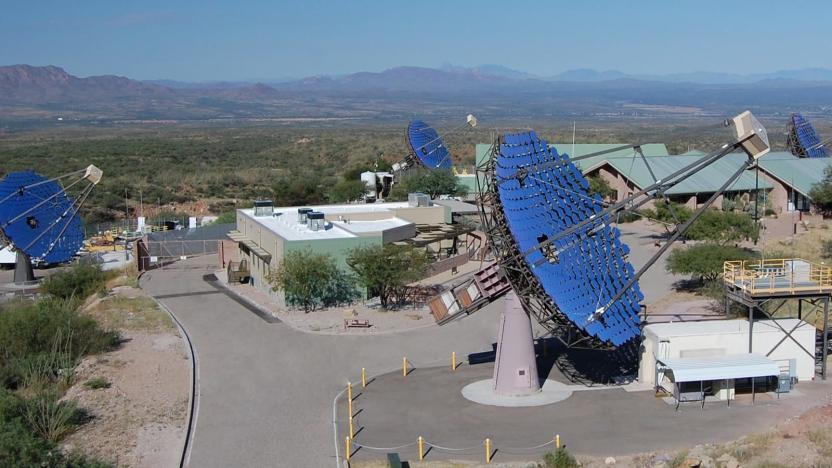breakthrough
Latest

Southern hemisphere’s largest radio telescope joins search for extraterrestrial tech
The Breakthrough Listen project will now be able to search more than a million stars within two years as it searches for signs of intelligent extraterrestrial life.

The FDA is fast-tracking an algorithm that screens for heart failure
Today, the FDA granted "breakthrough status" to an algorithm that could make screening for heart failure more accessible -- both in traditional clinics and telehealth settings. The algorithm uses a deep neural network developed by digital health company Eko and Mayo Clinic. With as little as 15 seconds of electrocardiogram (ECG) data, it can identify Left Ventricular Ejection Fraction (LVEF), a measure that's commonly used to diagnose patients with heart failure.

The first ever black hole image lands scientists $3 million prize
The scientists that captured the first image of a black hole are being rewarded with a $3 million prize. The Breakthrough prize, known as the "Oscars of Science," is sponsored by Silicon Valley execs such as Mark Zuckerberg and Sergey Brin, and recognizes top scientists in fields including life sciences, physics and math.

Breakthrough searches for signs of alien life in ultra-fast light pulses
Internet investor Yuri Milner's search for extraterrestrial life now includes a hunt for, effectively, interstellar Morse code. Breakthrough Listen is teaming with the partners behind VERITAS (the Very Energetic Radiation Imaging Telescope Array System) to search for nanoseconds-long optical pulses that could indicate the presence of aliens trying to flash messages across the cosmos. The collaboration will use all four telescopes at once to check for these light-based "beacons," which would could be brighter than stars observed in the same direction.

Researcher details method for teaching computers to win at board games through short training videos
All right, hotshot -- sure, you can trounce your five-year-old niece in a round of Connect Four, but are you ready to do battle with a machine? Łukasz Kaiser of Paris Diderot University in France has detailed a method for teaching computers how to learn relatively simple games like Tic-Tac-Toe, Breakthrough and the aforementioned eternal vertical struggle between checker pieces, using quick videos generally under two minutes in length. "The presented algorithm requires only a few demonstrations and minimal background knowledge," Kaiser explains, in his paper Learning Games from Videos Guided by Descriptive Complexity, "and, having learned the rules, automatically derives position evaluation functions and can play the learned games competitively." Kaiser adds, having taken on the world of Tic-Tac-Toe and other relatively simple games that, "there is strong theoretical evidence that it will generalize to other problems." Now if only we can sum up the world's issues Connect Four-style, we should be covered.

Researchers create spinal cord connectors from human stem cells, heralding breakthrough
It's taken many years and more than a bit of brainpower, but researchers at the University of Central Florida have finally found a way to create neuromuscular connectors between muscle and spinal cord cells, using only stem cells. Led by bioengineer James Hickman, the team pulled off the feat with help from Brown University Professor Emeritus Herman Vandenburgh, who collected muscle stem cell samples from adult volunteers. After close examination, they then discovered that under the right conditions, these samples could be combined with spinal cord cells to form connectors, or neuromuscular junctions, which the brain uses to control the body's muscles. UCF's engineers say the technique, described in the December issue of the journal Biomaterials, marks a major breakthrough for the development of "human-on-a-chip" models -- systems that simulate organ functions and have the potential to drastically accelerate medical research and drug development. These junctions could also pay dividends for research on Lou Gehrig's disease or spinal cord injuries, though it remains unclear whether we can expect to see these benefits anytime soon.

Researchers increase charging capacity, speed of lithium ion batteries by a factor of ten
It's not every day that we get to write about advancements in battery technology -- much less one as potentially groundbreaking as what a group of engineers at Northwestern University claim to have pulled off. In fact, Professor Harold Kung and his team say they've successfully managed to increase both the charging capacity and speed of lithium ion batteries by a factor of ten. The key, according to Kung, is the movement of the lithium ions nestled between layers of graphene. The speed at which these ions move across a battery's graphene sheets is directly related to how fast a device can recharge. To speed up this process, Kung decided to poke millions of tiny, 10-20nm-sized holes into a mobile battery's graphene layers, thereby providing the ions with a "shortcut" to the next level. As a result, Kung's perforated batteries were able to charge ten times faster than traditional cells, going from zero to hero in 15 minutes. Not satisfied with that achievement alone, Kung and his squad then set about increasing their battery's charging capacity, as well. Here, they increased the density of lithium ions by inserting small clusters of silicon between each graphene slice. This approach allows more ions to gather at the electrode and, by taking advantage of graphene's malleable properties, avoids some of the silicon expansion problems that have plagued previous attempts at capacity enhancement. The result? A battery that can run on a single charge for more than a week. "Now we almost have the best of both worlds," Kung said. "We have much higher energy density because of the silicon, and the sandwiching reduces the capacity loss caused by the silicon expanding and contracting. Even if the silicon clusters break up, the silicon won't be lost." There is, however, a downside, as both charging capacity and speed sharply fell off after 150 charges. But as Kung points out, the increase in charge retention would more than make up for this shortcoming. "Even after 150 charges, which would be one year or more of operation, the battery is still five times more effective than lithium-ion batteries on the market today," he told the BBC. For more technical details, hit up the links below.

Samsung breakthrough could turn your window pane into a big ol' LED
Samsung's quest for transparency won't end with laptops, apparently. Today, the Samsung Advanced Institute of Technology announced that its engineers have successfully created "single crystalline Gallium Nitride on amorphous glass substrates" -- an achievement that would allow the manufacturer to produce jumbo-sized LEDs from normal glass, including window panes. Samsung says this scaled-up approach will allow them to lower production costs relative to most LED manufacturers, which rely on sapphire, rather than glass substrates. And, whereas most Gallium Nitride (GaN) LEDs on the market measure just two inches in size, Sammy's technique could result in displays about 400 times larger. "In ten years, window panes will double as lighting and display screens, giving personality to buildings," a Samsung spokesperson told the Korea Herald. Unfortunately, however, it will likely be another ten years before the technology is ready to hit the market. Until then, we'll just have to do our late night window coding the old fashioned way. [Image courtesy of Columbia Pictures / The New York Times]

Paralyzed man can stand and walk again, thanks to spinal implant
Here's an amazing story to end your week on a high note: a 25-year-old paraplegic is now walking again, thanks to a groundbreaking procedure developed by neuroscientists at the University of Louisville, UCLA and Cal Tech. The Oregon man, Rob Summers, was paralyzed below the chest in 2006, after getting hit by a speeding car. This week, however, doctors announced that Summers can now stand up on his own and remain standing for up to four minutes. With the help of a special harness, he can even take steps on a treadmill and can move his lower extremities for the first time in years. It was all made possible by a spinal implant that emits small pulses of electricity, designed to replicate signals that the brain usually sends to coordinate movement. Prior to receiving the implant in 2009, Summers underwent two years of training on a treadmill, with a harness supporting his weight and researchers moving his legs. This week's breakthrough comes after 30 years of research, though scientists acknowledge that this brand of epidural stimulation still needs to be tested on a broader sample of subjects before any definitive conclusions can be drawn. Summers, meanwhile, seems understandably elated. "This procedure has completely changed my life," the former baseball player said. "To be able to pick up my foot and step down again was unbelievable, but beyond all of that my sense of well-being has changed." We can only imagine.

Researchers from Harvard and MITRE announce world's first programmable nanoprocessor
We've seen plenty of breakthroughs involving nanowires over the years, but none of those have involved an actual programmable processor -- until now, that is. That particular "world's first" was just announced by a team of researchers from Harvard University and the MITRE Corporation this week, and it's being described as nothing short of a "quantum jump forward in the complexity and function of circuits built from the bottom up." As for the processor itself, it consists of an array of nearly 500 germanium nanowires that have been criss-crossed with metal wires on a chip that's just 960 micrometers (or less than 1 millimeter) square. That becomes an actual processor when the researchers run a high voltage through the metal wires and switch the individual intersections off and on at will -- we're simplyfing things a bit, but you get the idea. What's more, the researchers note that the architecture is fully scalable, and promises to allow for the assembly of "much larger and ever more functional nanoprocessors." Head on past the break for the official press release. [Thanks, Chris]

Intel and Numonyx pave the way for scalable, higher density phase change memory
Both Intel and Numonyx have been talking up phase change memory for years now, but for some reason, we're slightly more inclined to believe that the latest breakthrough is actually one that'll matter to consumers. In a joint release, the two have announced a new non-volatile memory technology that supposedly "paves the way for scalable, higher density phase change memory products." Put as simply as possible, researchers have been testing a 64Mb chip that "enables the ability to stack, or place, multiple layers of PCM arrays within a single die," and the two are calling the discovery PCMS (phase change memory and switch). We know, you're drowning in technobabble here, but if these two can really apply Moore's Law to density scaling, you'll be thanking 'em as you pick up your $50 6TB hard drive in 2014.

Quantum cryptography: now ready for space travel
It's been awhile since we've heard of any major advancements in the world of quantum cryptography, but at long last the silence is being broken by a squad of jubilant Austrian physicists. As the story goes, a team from Austria's Institute for Quantum Optics and Quantum Information (IQOQI) managed to send "entangled photons" 90 miles between the Spanish islands of Las Palmas and the Balearics. Calling the ephemeral test successful, the crew has boldly asserted that it's now feasible to send "this kind of unbreakable encrypted communication through space using satellites." Funny -- last we remember, quantum cryptography still had a few kinks to work through here beneath the stratosphere.

Self-assembling polymer arrays could lead to larger hard drives, boastful Badgers
Most folks up in Madison are readying their face paint and stocking up on tailgating supplies, but the geeks among us (bless 'em!) are focusing their attention on something much more relevant to your future RAID array. A team from UW-Madison (along with partners from Hitachi) is getting set to publish a report that details a patterning technology that could offer performance gains over current methods while reducing time and cost of manufacturing. The process builds on existing approaches by "combining the lithography techniques traditionally used to pattern microelectronics with novel self-assembling materials called block copolymers." So, what does all this technobabble mean for you? Huge gains in density on patterned media, or if that's still not straightforward enough, ginormous HDDs in the near future.[Via Protein OS]

CNRS learns to control nanoscale strain in CPUs, heads to Jedi training
We've always heard that Chewbacca and friends had the power to control nanoscale strain in processors in a galaxy far, far away, but we Earthlings are just now getting caught up. Researchers at the Centre d'élaboration de matériaux et d'études structurales (CEMES-CNRS) have reportedly patented a measurement device that will essentially "enable manufacturers to improve microprocessor production methods and optimize future computers." We'll warn you, the meat of this stuff is pretty technical, but the take home is this: the technique has a good chance at "optimizing strain modeling in transistors and enhancing their electrical efficiency," which is just what we need for more potent chips that demand less energy. And that's something even a layman can appreciate.

Universal Display's white OLEDs go easy on the energy bill
Universal Display has a thing for outdoing itself, and just a month after patting itself on the back for setting a new OLED power efficacy record, the outfit is already celebrating an even larger achievement. Reportedly, the company has "successfully demonstrated a record-breaking white OLED with a power efficacy of 102 lumens per watt at 1,000 cd/m2 using its high-efficiency phosphorescent OLED technology." In layman's terms, this means that its OLEDs are sucking down less energy than ever before. In time (before 2015, actually), the US Department of Energy wants someone to create a 150 lm/W commercial OLED light source, and thanks to our trusty abacus, we can definitively say that Universal Display is getting mighty close to said goal. Oh, and considering how badly Sony's XEL-1 performed in power tests, we can only hope this stuff is applicable to the TV sector.

Physicists develop plastic semiconductors for laser diode use
Not to get all scientific on you or anything, but a team of Imperial physicists have just figured out a way to use plastics in laser diodes. For the uninitiated, scientists have been unable to make plastic semiconductor laser diodes because they had not yet found / developed "any plastics that could sustain a large enough current whilst also supporting the efficient light emission needed to produce a laser beam." Now, however, that obstacle has reportedly been overcome by making minor tweaks to a given plastic's chemical structure, and the resulting material will transport charges some 200 times better than before without impeding its ability to emit light. By the sound of things, the crew behind the breakthrough isn't quite ready to offer up the solution to manufacturers, but with a bit more work, we suspect that notion will change.[Via Slashdot]

IBM's racetrack memory dashing towards commercialization
So, how do you go about impressing the world after busting out a few systems based around the "fastest chip on Earth?" By getting us all worked up for a little thing called racetrack memory, that's how. Far from being the first memory technology that runs laps around the DIMMs we're relying on today, IBM researchers are suggesting that this iteration could enable users to store substantially more data at a lower cost and be available in around a decade. Put simply, the gurus working the project have discovered a way to overcome the prohibitively expensive process of manipulating domain walls in magnetic storage, essentially making a long-standing approach entirely more viable. If you're totally in nerd heaven right now, we assure you, checking out the explanatory video waiting after the jump is a must-do.[Via BBC]

New "Get a Mac" ads: Yoga and Breakthrough
Tonight, Apple premiered two new "Get a Mac" ads: Yoga and Breakthrough. These ads where shown during tonights episode of American Idol. You can look at these and other "Get a Mac" ads on Apple's website.These weren't the only new Apple ads to appear lately, Apple also released some new iPhone ads. Thanks Bob!

ICED makes game out of Immigration debate
A new free download game for PC and Mac looks to inform people of US immigration practices targeting legal permanent residents, asylum seekers, students and undocumented immigrants. GameDaily explains that ICED (I Can End Deportation), by international human rights organization Breakthough, seeks to give players another perspective on the immigration debate. Playing as one of five characters with different backgrounds the player can end up being deported, incarcerated, voluntarily deported or become a citizen.The game's designer, Heidi Boisvert, says the game was created to show people what happens to thousands of immigrants on a daily basis. She hopes that people will become more aware of the scope of the situation through the game and take action. The download is less than 100 MB and takes 15-45 minutes to play. At least this game is a little more sensitive and culturally relevant than Border Patrol.

Fujitsu achieves another storage milestone using patterned media technology
Although it seemed that Seagate was comfortably at the forefront of magnetic recording developments, Fujitsu is hoping that its latest "breakthrough" will add a little friction to the areal density competition. Using patterned media technology, the firm "was able to achieve a one-dimensional array nanohole pattern with an unprecedented 25 nanometer pitch," which essentially means that recording one-terabit per square inch onto HDDs of the future is now realizable. Additionally, the company also revealed a new development "involving perpendicular magnetic recording (PMR) read / write operation on random patterned media," which utilizes the soft underlayer (SUL) as the PMR media. As expected, the presenters weren't as forthcoming about when we'd actually see these achievements make a difference in our laptops, servers, and other HDD-equipped devices, but the sooner the better, okay Fujitsu?








